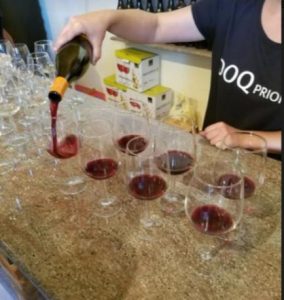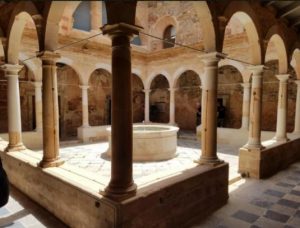Field trip to Priorat: “Which Landscape? Which Future?”
By Laurie Mangeli
Can someone say field trip? That feeling of boarding a bus to somewhere new never gets old. Priorat, a region located in southern Catalonia, is a rural area which back in the 19th century was made up of individual farms with a patchwork of vineyards.

Wine at Cooperativa de Gratallops
Laurie Mangeli photo
Our first stop was Cooperativa de Gratallops (Vinicola del Priorat). We were welcomed by the coordinators of the association who discussed the history of Priorat. It’s growth in the vineyard industry, was ignited by encroaching windfarms – a strategy of development from the urban area. The community came together to fight this movement in order to protect the stature of nature and landscape in Priorat. They did this by creating cooperatives by which the community came together to integrate agriculture and vineyards. The population of Priorat increased significantly until the late 19th century when the Phyloxerra (bug) pandemic destroyed the vineyards causing a 2/3 decline in population which has never recuperated. Current challenges the area faces is their mountain terrain which prevents modernized harvest and for that reason they chose to specialize in high-quality wine to compensate for quantity. With this, they are also striving to be inscribed on the world heritage list of UNESCO. Currently, farmers are growing old and retiring thus they’re trying to get younger farmers through the cooperatives. A trip to a vineyard cannot be complete without tasting some classic red wine poured out for us by Roser Vernet.

Monastery at Escaladei
Laurie Mangeli photo
Our next stop was Escaladei to visit the ruins of a monastery. Due to the narrow roads, not built for much traffic, we took a small hike to the monastery which allowed us to appreciate the cultural landscape. We saw workers tending to the vineyards during our hike which gave a greater appreciation of the time poured into this industry. The monastery served as a sanctuary for the monks, and from the architecture, it was clear that there was influence from muslim culture with the architecture which dates back centuries.
Our final stop was in Cornudella de Montsant where we met with restaurant owner and entrepreneur Jayne Giral. We had an opportunity to appreciate the local quality products which have attracted tourists. He defined the struggles of having a business in a rural area. However, despite the struggles there is much pride in what he does. Walking distance from the restaurant is Cornudella Cooperative which is unfortunately not as fruitful as Cooperativa de Gratallops thus there is talk of having the cooperative serve as a museum in order to encourage the tourism industry in the area.
